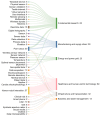Navigating the Evolution of Digital Twins Research through Keyword Co-Occurence Network Analysis
- PMID: 38400360
- PMCID: PMC10893128
- DOI: 10.3390/s24041202
Navigating the Evolution of Digital Twins Research through Keyword Co-Occurence Network Analysis
Abstract
Digital twin technology has become increasingly popular and has revolutionized data integration and system modeling across various industries, such as manufacturing, energy, and healthcare. This study aims to explore the evolving research landscape of digital twins using Keyword Co-occurrence Network (KCN) analysis. We analyze metadata from 9639 peer-reviewed articles published between 2000 and 2023. The results unfold in two parts. The first part examines trends and keyword interconnection over time, and the second part maps sensing technology keywords to six application areas. This study reveals that research on digital twins is rapidly diversifying, with focused themes such as predictive and decision-making functions. Additionally, there is an emphasis on real-time data and point cloud technologies. The advent of federated learning and edge computing also highlights a shift toward distributed computation, prioritizing data privacy. This study confirms that digital twins have evolved into complex systems that can conduct predictive operations through advanced sensing technologies. The discussion also identifies challenges in sensor selection and empirical knowledge integration.
Keywords: artificial intelligence (AI); digital twins (DT); keyword co-occurrence network (KCN); scientometric analysis; sensors.
Conflict of interest statement
The authors declare no conflict of interest.
Figures












Similar articles
-
Exploring the Potential of Digital Twins in Cancer Treatment: A Narrative Review of Reviews.J Clin Med. 2025 May 20;14(10):3574. doi: 10.3390/jcm14103574. J Clin Med. 2025. PMID: 40429568 Free PMC article. Review.
-
Application of Artificial Intelligence in rehabilitation science: A scientometric investigation Utilizing Citespace.SLAS Technol. 2024 Aug;29(4):100162. doi: 10.1016/j.slast.2024.100162. Epub 2024 Jul 4. SLAS Technol. 2024. PMID: 38971228
-
Integrating Digital Twins with IoT-Based Blockchain: Concept, Architecture, Challenges, and Future Scope.Wirel Pers Commun. 2023 Jun 8:1-24. doi: 10.1007/s11277-023-10538-6. Online ahead of print. Wirel Pers Commun. 2023. PMID: 37360142 Free PMC article.
-
Enhancing Healthcare through Sensor-Enabled Digital Twins in Smart Environments: A Comprehensive Analysis.Sensors (Basel). 2024 Apr 27;24(9):2793. doi: 10.3390/s24092793. Sensors (Basel). 2024. PMID: 38732899 Free PMC article. Review.
-
Integrating the digital twin concept into the evaluation of reconfigurable manufacturing systems (RMS): literature review and research trend.Int J Adv Manuf Technol. 2023;126(3-4):875-889. doi: 10.1007/s00170-023-10902-7. Epub 2023 Mar 7. Int J Adv Manuf Technol. 2023. PMID: 37073281 Free PMC article. Review.
References
-
- Schwer L.E. An overview of the ASME V&V-10 guide for verification and validation in computational solid mechanics; Proceedings of the 20th International Conference on Structural Mechanics in Reactor Technology; Espoo, Finland. 9–14 August 2009; pp. 1–10.
-
- Grieves M. Digital twin: Manufacturing excellence through virtual factory replication. White Pap. 2014;1:1–7.
-
- Van der Valk H., Haße H., Möller F., Arbter M., Henning J.L., Otto B. A Taxonomy of Digital Twins; Proceedings of the AMCIS; Online. 15–17 August 2020.
-
- Wooley A., Silva D.F., Bitencourt J. When is a simulation a digital twin? A systematic literature review. Manuf. Lett. 2023;35:940–951. doi: 10.1016/j.mfglet.2023.08.014. - DOI
-
- Lysova N., Solari F., Vignali G. Optimization of an indirect heating process for food fluids through the combined use of CFD and Response Surface Methodology. Food Bioprod. Process. 2022;131:60–76. doi: 10.1016/j.fbp.2021.10.010. - DOI
Publication types
LinkOut - more resources
Full Text Sources

